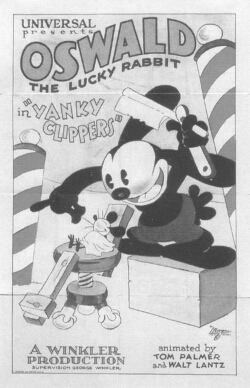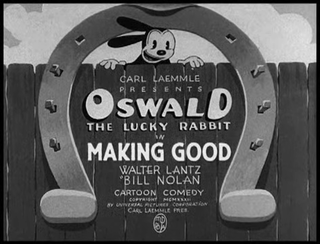Related Research Articles

Pluto is an American cartoon character created by the Walt Disney Company. He is a yellow-orange color, medium-sized, short-haired dog with black ears. Unlike most Disney characters, Pluto is not anthropomorphic beyond some characteristics such as facial expression. He is Mickey's pet. Officially a mixed-breed dog, he made his debut as a bloodhound in the Mickey Mouse cartoon The Chain Gang. Together with Mickey Mouse, Minnie Mouse, Donald Duck, Daisy Duck, and Goofy, Pluto is one of the "Sensational Six"—the biggest stars in the Disney universe. Though all six are non-human animals, Pluto alone is not dressed as a human.

Hare Tonic is a 1945 Warner Bros. cartoon in the Looney Tunes series, directed by Chuck Jones and written by Tedd Pierce. It stars Bugs Bunny and Elmer Fudd, making this the second cartoon directed by Jones to co-star the two. Voice characterizations are by Mel Blanc and Arthur Q. Bryan.

Elmer J. Fudd is an animated cartoon character in the Warner Bros. Looney Tunes/Merrie Melodies series and the archenemy of Bugs Bunny. His aim is to hunt Bugs, but he usually ends up seriously injuring himself and other antagonizing characters. He speaks in an unusual way, replacing his Rs and Ls with Ws, so he often refers to Bugs Bunny as a "scwewy" or "wascawwy (rascally) wabbit". Elmer's signature catchphrase is, "Shhh. Be vewy vewy quiet, I'm hunting wabbits", as well as his trademark laughter.
The Ugly Duckling is an animated black-and-white cartoon released by Walt Disney in 1931 as part of the Silly Symphonies series. This cartoon was later remade into a color version released in 1939, which follows the original Andersen story much more faithfully. This gives The Ugly Duckling the unique distinction of being the only Silly Symphony to be made twice. This film was then sold to reach about 4,000 dollars per month at the most profit, because it slowly climbed up the scale of growth.

Elmer the Great Dane is a Walter Lantz character in the Oswald the Lucky Rabbit cartoon series, who premiered in the 1935 short Elmer the Great Dane. The character's name is most likely a reference to Elmer, the Great, a 1933 film.

Weary Willies is a 1929 animated short produced by George Winkler which stars Oswald the Lucky Rabbit. The film is also the penultimate Oswald cartoon created during the Winkler period.

Yanky Clippers is a 1929 silent animated film starring Oswald the Lucky Rabbit. It is among the few shorts created during the Winkler period known to exist. The cartoon is also Oswald's last silent film.
Lovesick is a 1937 cartoon produced by Walter Lantz Productions featuring the later, post-1935 white-furred version of Oswald the Lucky Rabbit, together with his dog Doxie the dachshund.
Oil's Well is a 1929 short animated film starring Oswald the Lucky Rabbit and produced by Walter Lantz Productions. It is the 2nd Lantz Oswald film and the 54th in the entire series.

The Ginger Bread Boy is a 1934 animated short by Walter Lantz Productions and is among the many films of the Oswald the Lucky Rabbit series. The story mentioned in the cartoon is based on "The Gingerbread Man", published in St. Nicholas Magazine in 1875.

The Busy Barber is a short animated film by Walter Lantz Productions, starring Oswald the Lucky Rabbit. It is the 64th Oswald short by Lantz and the 116th in the entire series.
Quack Shot is a 1954 American animated comedy short film directed by Robert McKimson. The cartoon was released on October 30, 1954 as part of the Merrie Melodies series, and stars Daffy Duck and Elmer Fudd.
Grandma's Pet is an animated short film by Walter Lantz Productions and is part of the Oswald the Lucky Rabbit series. It is the 53rd Lantz Oswald cartoon and the 106th cartoon overall.

Wax Works is a 1934 animated short subject by Walter Lantz and features Oswald the Lucky Rabbit.

The Bandmaster is a 1931 short film by Walter Lantz Productions, starring Oswald the Lucky Rabbit. As with a few films from the series, the cartoon is in the public domain. A similarly titled short, also produced by Lantz in 1947, is still under copyright however.
Kounty Fair is a 1930 animated cartoon released by Universal Pictures starring Oswald the Lucky Rabbit.

The Quail Hunt is a 1935 short theatrical cartoon by Universal Pictures starring Oswald the Lucky Rabbit. It is the 106th Oswald cartoon by Walter Lantz Productions and the 157th in the entire series. This is one of the last two shorts to feature Oswald in his 1920s style, the last official appearance of his 1920s style was Monkey Wretches.

The County Fair, also called The Country Fair in some reissues, is a short animated film distributed by Universal Pictures, in the Oswald the Lucky Rabbit series. The cartoon shares a very similar title with Kounty Fair, another Oswald short released four years prior.
The Candy House is a 1934 short animated film by Walter Lantz Productions featuring Oswald the Lucky Rabbit. The film is an adaptation of the fairy tale Hansel and Gretel by the Brothers Grimm and is one of the few Oswald shorts in which he plays a different character.

Making Good is a 1932 animated short film by Walter Lantz Productions, starring Oswald the Lucky Rabbit. It is the 57th Oswald film by Lantz's studio and the 110th overall. The film had an original copyright notice, but it was not renewed.
References
- ↑ Scott, Keith (2022). Cartoon Voices from the Golden Age, 1930-70. BearManor Media. p. 208. ISBN 979-8-88771-010-5.
- ↑ Lenburg, Jeff (1999). The Encyclopedia of Animated Cartoons. Checkmark Books. pp. 115–116. ISBN 0-8160-3831-7.
- ↑ Catalog of Copyright Entries - Motion Pictures 1936. Library of Congress. 1936. p. 302. Retrieved May 20, 2023.
- ↑ Catalog of Copyright Entries - Motion Picture Renewals 1964. Library of Congress. 1964. p. 117. Retrieved May 20, 2023.